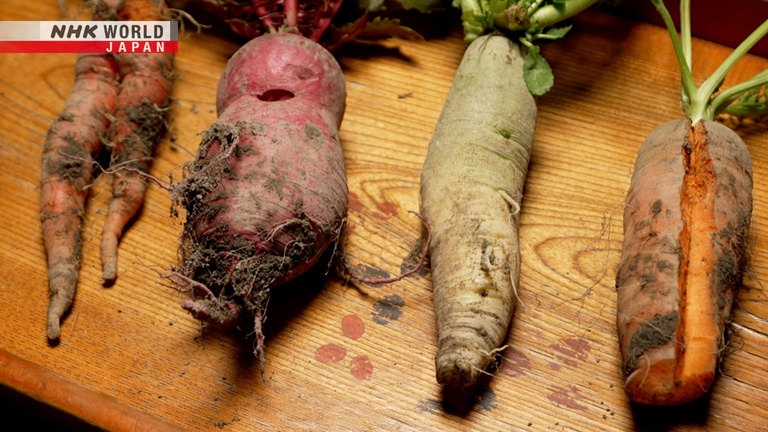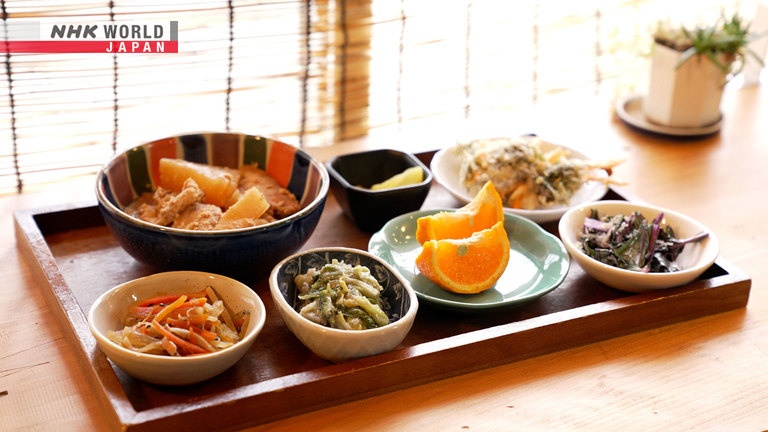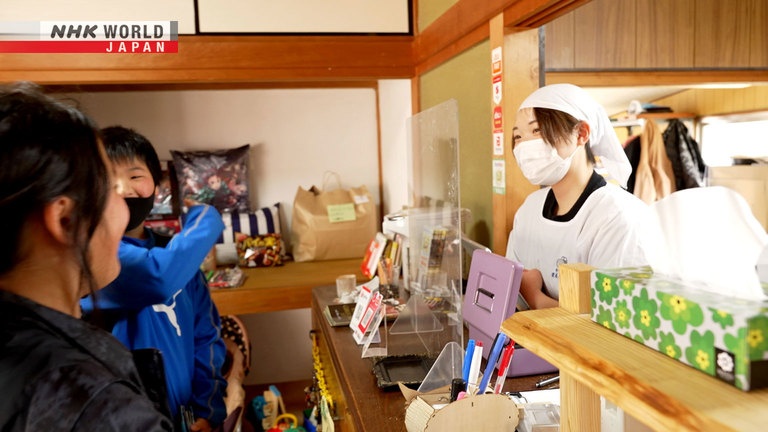Eatery Happiness Exchange
Produce is generally uniform in color, shape and size due to strict standards, which also makes for improved efficiency, but it means deviations aren't tolerated. Suyama Chimi, who studied agriculture at university, set out to open an eatery using the waste generated, so-called "substandard" produce donated by local farmers. Since costs are low, the meals are low-cost too. In the kitchen every day since graduation, her place is always busy and has become a hub for the nearby community.



Transcript
Since ancient times, the Japanese have believed that a life force resides in all creations.
Valuing and caring for the things we use, a "Zero Waste Life."
Pointing the way to better living for a new era.
I think all people have
the desire to help others.
This place gives form to those feelings.
Kami, a rich farming region in Kochi Prefecture, western Japan.
Here we find a small eatery.
Hello. Welcome!
It's operated by Suyama Chimi, who just graduated from university one year ago.
Hot.
It's too hot to taste.
With its homey atmosphere, once again today, all seats are taken.
Every item on its nutrition-conscious menu costs no more than 7 USD.
But that's not the only reason it's special.
Ah, thank you.
I really appreciate it.
A farmer from the area has brought in some eggplants that were too small to sell.
Similarly, those that are too large, discolored, or misshapen, are classed as "sub-standard" and ordinarily disposed of.
This eatery gets these vegetables for free, allowing them to offer such reasonably priced meals.
At the end of lunch service for the day, Suyama heads out...
Her destination, Sakamoto farm, a regular contributor of fresh produce.
Twist it out like this.
It's huge!
It's too big around.
Oversized, this daikon radish is unsellable.
And even vegetables that may look fine at first glance can be labelled "substandard," due to subtle differences in appearance.
The stems are too far apart,
and the leaves are a bit firm.
This one can go to the distributor
but this one goes to Chimi's eatery.
In the past, Sakamoto regretfully disposed of any substandard produce.
We ate some ourselves, but it was a lot,
so the remainder was sadly destroyed.
But the restaurant will take anything,
even in small amounts.
We're grateful she has a use for it.
Now back at the eatery, Suyama contemplates the next day's menu based on what's she's received.
I'm thinking stewed pork and radish
for the main dish.
Leftover daikon peel from today's salad
could be cooked with the carrots.
And maybe the carrot leaves
could be used for tempura...
I might change my mind as I cook.
The next day.
Preparation begins in the morning.
How to do it...?
It's like cutting a watermelon.
Not only does she use substandard produce, but also things like carrot leaves, daikon peels and other things normally thrown away.
My dad taught me that the peel
is the most nutritious part.
I try to use everything edible.
Sometimes the parts we throw out
are actually the most delicious.
In Suyama's hands, produce that was destined for disposal is transformed into delicious and healthy food.
Sweet & spicy pork with daikon Carrot leaf tempura
You want seconds?
Here, rice and soup are all-you-can-eat.
Growing children need to eat well,
and I have so many of them myself.
So, it's great that it's all-you-can-eat.
Rice and soup make a meal by themselves.
I want everyone to go home
full and totally satisfied.
Suyama opened her eatery while she was still studying agriculture at university.
I was interested in agriculture and
visited several farms for school...
learning farm management,
but I started noticing the food waste.
I saw many examples of perfectly edible
produce thrown away or unsold...
just because of shape or appearance.
Finding a use for these unused vegetables, offering them to those who need them at a reasonable price, was the idea behind her eatery, but making it happen wasn't so easy.
People said it was great,
but it was just some student's idea.
Nobody thought I'd make it happen.
It was just a passing fancy.
But I was determined
and started looking at locations...
and farmers willing to help.
Her efforts bore fruit; finding farmers willing to provide the ingredients and borrowing space in an off-hours cafe, she opened for business, at first offering food service only in the evening.
Half a year later, when she decided open her own eatery, she received additional support from the people in the area.
They offered to make tables and
even gave me a commercial fridge.
In the end, I got so many donations
I hardly had to buy a thing.
It was a real surprise.
Her successfully opened restaurant is now approaching its second anniversary.
And it's become an important place for the local people.
Farmers and other customers often help out in the kitchen, supporting Suyama's efforts.
Inoue Hiroto, age 12, is one of them.
Mainly Saturdays.
With no soccer during the pandemic
it's something to do.
What do you like about it?
Talking with everyone...
and getting a free meal.
Those who benefit have the desire to pass it on.
Here at Suyama's eatery, kindness is routine.
If you have extra,
you pass it on to someone else.
You get the joy of giving,
giving joy to someone else.
As well as the thing itself, they
get the joy of knowing someone cares.
It's an exchange of happiness.